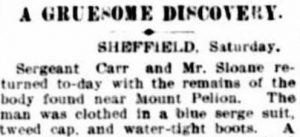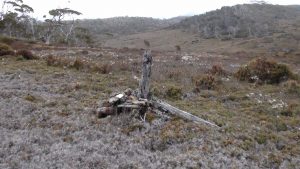Thomas Connolly, the publican of the Rosebery Hotel, walked towards a prospectors’ camp near Barn Bluff on 20th March 1901. His swag was found at Lake Windermere a few kilometres from his destination but he had disappeared.
George Sloane, a tragic figure in his own right, is forever associated with Thomas Connolly.[1] In late 1901, George and Bill Todd had finished prospecting in the headwaters of the Forth River near the frowning brow of Mount Pelion West. Todd dismantled their camp and Sloane packed it back along the Mole Creek Track. On the February Plains, at the top of Wurragarra Creek, Sloane took a shortcut.[2] One mystery would be solved but another would begin.

Sloane turned east from the track and across a small open plain. That day, 30th November, he found a skeleton by a log about 100 metres from the Mole Creek Track.[4] The descriptions of the remains vary. It was reported that ‘the flesh and all the smaller bones had been eaten by wild animals, but the bigger bones are perfect, and the clothes are still sound enough to be handled’.[5] Others said that ants had eaten the flesh.[6] The tradition handed down by the hunters and prospectors of Mole Creek is that some bones were carried into the bush by animals.[7]

Sloane returned to his old camp to get Todd. He would guard the body while Sloane went for the police in Sheffield. On 5th December, Sloane and Sargent J Carr returned with three horses to recover the remains. Sloane had already had a good look at the possessions. He was sure that it was Thomas James Connolly, last seen on 20th March. According to tradition a full bottle of brandy was found with the remains but this did not appear in the detailed inventory of effects found.[8]

Sloane and Carr returned to Sheffield on the evening of 7th December. There seemed little doubt that the remains were Thomas Connolly because his wife Agnes and brother Denis were summoned to the inquest as witnesses.
The inquest was held on 10th December. The procedure was quick. Sloane described how he found the remains.
Carr listed the possessions recovered with the body; ‘clothing, boots, watch, knife, pocket book, white – Indian silk handkerchief with a peacock worked in the centre, two £1 notes and a blank cheque form No. 48,642, Bank of Australasia, Zeehan.’[9]
Agnes Connolly gave greater detail of her husband’s possessions when he left nine months earlier. His boots were new and water tight. His suit was made of blue serge and he wore a tweed cap. The watch was ‘a Waterbury watch with a white metal chain’, the penknife was ‘a small white-handled knife with one blade broken’, the pocket book containing a list of articles purchased for the journey and the address of a sister-in-law in Victoria’.[10] She believed that ‘the watch produced to be her husband’s, also the knife and handkerchief, pocket-book and handwriting.’
Denis Connolly described the search of Thomas. There was little doubt about the case, the remains were Thomas James Connolly and that he had died of cold and exposure.
Finally, on the 12th December, Thomas James Connolly, the publican from Rosebery, was buried quickly at the Latrobe Cemetery.[11] He seemed to have no association with Latrobe and the burial was barely reported. After the drama of his disappearance, the discovery of his body and the inquest, his life was concluded in almost a complete silence. There were no homages to Thomas in the newspapers.
But some questions still remained. At the inquest, George Sloane turned to the foreman of the inquest and said that he ‘understood that the Pelion Huts were occupied by travellers in March last’. It was obvious to him that it was unlikely that Thomas Connolly had walked 25 kilometres from his destination, without his swag and that he was not seen by anyone in the huts and he had not sought shelter there either.[12] This mystery has not been answered since it was asked by Sloane.
The mystery of his last days has been kept alive by the hunters of the Mersey high country. They told and retold the story around campfires. They knew details that were lost to many. The February Plains where the body was found is a big place. If it wasn’t for the hunters and those that chronicled their stories the precise location of his remains would be lost. The mystery had been made more confusing by the newspapers of the day throwing around place names with abandon; Pelion, Pillinger, Forth and the February Plains as if they were the one place.

The high country people kept Thomas’ memory alive when many had forgotten. They could point to a bush, they called it “Connolly’s Bush”, a small cider gum, where he was found. They could tell the story of Connolly’s disappearance and discovery but they couldn’t explain the great void between those two places, his destination and where he was found – ‘it was a mystery what happened to him’.[13]
The written histories recorded by the newspapers and government documents tell us a lot about Connolly. The delicate thread of the oral histories that tell us much more. Walk into this country armed with these histories, look at the landscape and the pieces of the puzzle fall together. Connolly’s last days can be explained at last.
Ian Hayes and Peter Brown, copyright MountainStories.net.au 2019
Part 4 – TJ Connolly’s Last Journey
[1] George Sloane committed suicide in 1921, Advocate, 3 Mar 1921, p 2
[2] Advocate, 27 Mar 1936, p 11
[3] Launceston Examiner, 9 Dec 1901, p 6
[4] Daily Telegraph, 14 Dec 1901, Page 5
[5] North West Post, 7 Dec 1901, p 3
[6] Examiner, 6 Dec 1901, p 6
[7] Ned Terry, Identities and History of Tasmania’s High Country, Artemis Publishing, 2005, p 132
[8] Ned Terry; Curiously Connolly had bought three bottles with him but only two were found with his swag at Lake Windermere. Did Todd make use of the third bottle during his lonely vigil or did Connolly leave it somewhere in his difficult journey from Lake Windermere to the February Plains?
[9] North West Advocate and Emu Bay Times, 12 Dec 1901; Zeehan and Dundas Herald,13 Dec 1901, page 4
[10] The watch is still held by the Connolly family – as mentioned in Facebook July 2019; Daily Telegraph 12 Dec 1901.
[11] Daily Telegraph, 14 Dec 1901, Page 5
[12] Zeehan and Dundas Herald,13 Dec 1901, page 4
[13] Ned Terry p 132
Thank you so much for addressing the mystery of the disappearance of my great uncle Thomas James Connolly. It has been an unfinished story in our family for many years and you have shed a light on what happened. I am a grandaughter of Denis Connolly.
I have photos of Thomas’s wife Agnes and daughters Eileen and Marie if you would like to have copies. Thank you, Jenny Bangs.
Thanks so much for you comments. It would be great to have copies of the photos of Thomas’ family. Could you send them to us at info@mountainstories.net.au , Peter
I am the great grandson by marriage of George Sloane. I am really indebted to this research for adding so much to my familys knowledge of George. I knew of George’s discovery of a body on pelion plains but now knowing of Thomas and his heritage adds so much more humanity to the history
Thank you for your comment. George Sloane certainly is a fascinating person, his life hasn’t got the attention it deserves. He has been on our radar for a while. We hope to look do something about him in the future. Family members always have great insights. Regards Peter